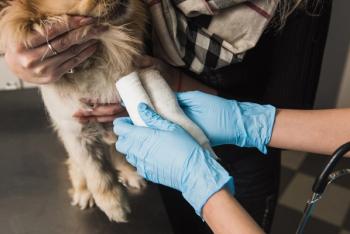
Life-saving strategies: Important considerations in emergency medicine
A Q&A with emergency and critical care veterinary practitioner Susan Barnes
DVM: Tell us about your experience in emergency medicine and critical care.
Barnes: I have been in clinical practice for 28 years. My first four years were in a large, high-volume medical/surgical practice where I saw emergencies, though my beginnings actually were before I became a veterinarian, as an assistant technician. For the past 24, going on 25 years, my practice is dedicated to emergency critical care medicine and surgery.
Susan M. Barnes
DVM: How would you describe your work as an emergency-medicine practitioner?
Barnes: My work is challenging and exciting. There's never a dull moment, with always one more or multiple things to do. It can be emotionally draining, though very rewarding.
DVM: As the immediate past president of the Veterinary Emergency and Critical Care Society [VECCS], tell us how it can help veterinarians?
Barnes: VECCS has an annual international meeting. The continuing education tracks range from basic to expert care. Then there is the less-formal spring symposium that's always informative and cutting-edge for attendees. The group is evolving to meet members' needs, and the website,
DVM: How has your work changed in recent years with, say, new technologies or practices?
Barnes: There has been quite an evolution over the years, all for the good. First, there's been a rise in 24-hour emergency facilities. Previously, we would save lives and then transfer patients elsewhere and never know what happened to them. Now we can see the continuum of care — how the animal is trending — which is very important for patient care. Long ago, I recognized, as did many others, a great need for 24-hour intensive care, and I'm happy to see that need has largely been fulfilled.
Second, there's been the development of the Veterinary Technician Specialist [VTS] groups, such as the Academy of Veterinary Emergency & Critical Care Technicians. We have two full-time and two part-time VTSs certified in emergency and critical care who are terrific, very knowledgeable and experts in our field. They've made my job so much easier. They improve patient care and allow me more time to speak with families and clients. They ask questions and provoke thoughts and have raised the level of patient care.
Third, the availability of advanced imaging equipment has changed our capabilities and work. Now I can expedite the conclusion of a diagnosis and counsel the client on life-saving strategies and maneuvers that improve outcomes and quality of life. With these technologies, we quickly learn more about the patient's status. Also, the availability of technology to help with critical-care ventilation has helped. This technology can sustain life while we do our jobs.
Finally, there's the improvement in transfusion products. Previously, we had to go through the time and trouble to find a donor. New transfusion products and typing and crossmatching techniques have helped with patients that have, for example, massive blood loss through trauma or other clotting disorders.
DVM: What are the most significant advances for this specialty during the past five years?
Barnes: Significant advances include digital radiography that allows us, in a timely fashion, to diagnose accurately. It's especially helpful in interpreting simple cases. Also, the increased availability of ultrasonography has helped us more accurately treat shock patients. For example, we can see if there is free fluid in the abdomen or chest. With point-of-care testing we can act on information in a real-time manner. And improved availability of the intravenous infusion pumps enables improved accuracy of intravenous continuous infusion monitoring and identifying trends.
DVM:Timing is everything, especially in responding to trauma. Can you offer advice to a primary care practitioner when it comes to stabilizing an animal after it has suffered a traumatic event, such as a car accident?
Barnes: Be prepared for basic resuscitation. Indecisiveness can result in delay of care and loss of life. The best way to help a trauma victim is with what I call the 3Ps: pain management, perfusion and pulmonary care. Patients should be treated for shock and pain.
DVM: What about the role of pain management when faced with a traumatic case? When do you treat?
Barnes: Always. Pain should always be treated. A patient should never have to endure pain.
DVM: Why should primary care practitioners consider referring their clients, when possible, to emergency clinics rather than trying to deal with critical cases themselves?
Barnes: Primary care veterinarians do a great job of delivering preventive healthcare. But they should refer to emergency clinics when rapid decision-making will save lives. The primary care veterinarian can stabilize the animal that is, say, arresting, and then transfer the animal to the closest emergency clinic where there are people with the necessary experience, resources and 24-hour care. Often, those patients have the best outcomes.
DVM: When it comes to emergency medicine, can you bust a myth or two in terms of treatment?
Barnes: Oh, yes, there are many myths I can bust:
1. It used to be said not to treat for pain because it would mask the signs or would prevent detection of worsening signs. That is totally untrue. Pain should always be treated.
2. In past years, it's been as the pendulum swings with use of corticosteroids and glucocorticoids. At present, these should not be used to treat shock, snake envenomations or intervertebral disk disease. Rather, they are used at varying doses to treat inflammation and for immunosuppression. Physiologic doses are administered to supplement adrenal gland or cortisol deficiencies.
3. Any patient with pericardial effusion is not stable, nor is any patient that has a diaphragmatic hernia.
DVM: What advice would you give primary care practitioners about effective emergency medicine — that is, what should they know about basic emergency veterinary medicine?
Barnes: The importance of preparedness. Use the 3Ps I noted earlier.
In addition to joining and using the Veterinary Emergency and Critical Care Society as a resource, refer early to critical care and emergency specialists, and don't be shy about asking for advice before transporting a patient for intensive 24/7 care. A primary care practitioner can perform life-saving care, as can the closest emergency clinic, followed by transfer to an emergency specialty facility that you trust to carry through any resuscitative effort begun. A primary care practitioner should be confident that any 24-hour practice in his or her area has the resources and will be available, so the best care possible is provided to the patient. This will allow the patients to return to their primary care practice, hopefully, for many healthy years to come.
DVM: What are some of the best ways to deal with a distraught client when he or she brings in a pet during an emergency?
Barnes: You have to put yourself in the client's shoes. Most of us in veterinary care have pets, so we know what clients must be feeling. Be empathetic, show concern and communicate as soon and as often as possible. Include the client in the decision-making process when you can. Acknowledge the relationship the client has with his or her primary care practitioner. Communicate with the primary care practitioner often and regularly.
In short, listen to the client, show respect for the client and primary care practitioner, really hear clients' wishes and then — and this is important — document those wishes.
DVM: What should be avoided in client-management situations?
Barnes: Avoid delay in reuniting the patient with the client. Allow the client to see the pet as soon as possible. Also, don't get caught up thinking the client is somehow inconvenient. You're doing all of this for the client, for a family. Never, ever have the thought that the client is in the way.
Remember, words are powerful, so use them carefully. Don't resort to harsh words and don't be indifferent. Keep the client informed as best you can. Speak in a soothing voice. Be a "patient advocate" for the pet, your patient.
Finally, avoid bringing clients to an area that's barely cleaned. Pick up the fur balls and wipe the blood from the floor. It gives clients a good impression if the area is clean.
DVM: Are there any other key concepts to consider when dealing with emergency situations?
Barnes: Offer the best care, but have other options, too. We use whatever works, up to and including some alternative therapies such as acupuncture. Stay current on the latest trends in emergency and critical care.
Also, I recommend humane euthanasia only in two circumstances: When the patient is in inordinate pain that I can't manage via multiple options, or when the patient is suffocating and suffering, such as in cases of severe lung damage, cancer or end-stage heart disease. Sometimes there will be financial considerations that come into play with these. Sometimes all the money in the world doesn't matter.
DVM: As pets live longer, are you seeing a greater number of geriatric-related conditions? Can you describe your caseload in this regard?
Barnes: The number of older pets we see definitely is growing. Today, 33 percent to 45 percent of our patients are geriatric, and that's up from previous years. I attribute the increased longevity to better care throughout their lives. That's the beauty of the relationship between primary care practitioners and their clients and patients. Primary care practitioners are educating their clients. There's more information available for clients, and primary care practitioners are doing well in basic preventive care and wellness evaluations.
DVM: Are you noticing a tendency for clients to have stronger bonds with their pets in recent years?
Barnes: There's always been a strong bond, but, yes, it does seem to be getting stronger. For many, the human-animal bond is as strong as any bond with a human family member.
DVM: How do you foresee emergency medicine changing in the future? Any new technologies or practices you think hold promise?
Barnes: There are many exciting things happening in this field. Some are not so new but are just now becoming more widely known and available. For example, hyperbaric oxygen therapy increases oxygen delivery to cells and helps with healing. There have been some trials conducted with dogs that show response and real promise.
Advances in some interventional radiographic technologies are being applied to emergency medicine, and that's something to watch for in the future, as are advances in chronic renal replacement therapy or hemodialysis.
Editor's Note: Susan M. Barnes, DVM, is the medical director of Animal Emergency Critical Care Associates at The LifeCentre, a full-service veterinary emergency, critical care and specialty center in Leesburg, Va., and the immediate past president of the Veterinary Emergency and Critical Care Society.
Loyle is a freelance medical editor and writer in Philadelphia and the former primary editor of the North American Veterinary Licensing Examination.
Newsletter
From exam room tips to practice management insights, get trusted veterinary news delivered straight to your inbox—subscribe to dvm360.




